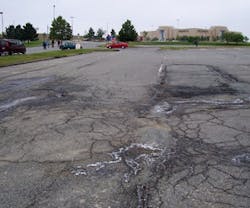The number one cause of premature pavement failure is poor drainage of the pavement surface, subbase, or subgrade. Reduce your risk of premature pavement failure by installing an underdrain system.
Pavement Basics
All pavements, whether they are asphalt or concrete, rely on a solid base. This assures that the movement of the pavement is kept to a minimum, extending its life. Once pavement material is subjected to excess water that pushes it beyond optimum moisture content, the base of the pavement structure becomes soft and unstable.
Once an asphalt base loses its rigidity, the pavement will either settle, over-flex, or crack. A compromised concrete base may not be able to bridge the soft area, causing the concrete to crack and fault. Subsurface water can also cause the subbase or subgrade to wash into unsealed pipes or structures, resulting in settlement and failure. In northern climates, moisture in the pavement structure will cause heaving when trapped water freezes.
Inspect for Problems
The presence of subsurface moisture can be detected through comprehensive visual inspection, sometimes supplemented with a geotechnical investigation. During morning inspections, look for moisture at any cracks or raveled areas, unsealed joints, low points, and curbs. Utility structures such as light pole bases are another good place to look because water will follow underground lines that are backfilled with porous materials.
If the pavement is inspected in the afternoon after the moisture has dried up, stains will be evident where the water has been weeping to the surface. In some cases, fine aggregates or sand from the subbase will be washed to the surface and cause white residue to form around the cracks. In extreme instances, algae growth will appear on the pavement or on the sides of pole bases due to the constant water presence.
Another place to look for subsurface moisture is in the drainage structures. Subsurface water will often weep into structures at pipe joints, brick joints, or through cracks. Geotechnical exploration or borings will reveal the presence of moisture in the subbase and subgrade, but it also adds costs to the investigation.
Drain Away Moisture
The best option to improve subbase drainage and reduce the risk of premature pavement failure in an existing parking lot is to install an underdrain system to allow moisture a point of relief. The system drains water away from the pavement structure and into existing catchbasins, curb inlets, storm pipes, retention ponds, or ditches.
The underdrain system is typically made up of a perforated pipe that is placed in a fabric-lined trench approximately 24 inches below the surface of the pavement and backfilled with clear stone. Subsurface water flows into the porous system and is carried away from the pavement structure.
Careful selection for the underdrain line locations is necessary and should extend from the outfalls (typically a catchbasin) to areas of suspected subsurface moisture. At pavement edges where water enters or exits the lot, a line of underdrain can be placed parallel to the edge to prevent the water from seeping under the pavement.
Pay Now to Save Later
The average cost of installing an underdrain system in an existing parking lot can range from $30-45 per linear foot (LF). The cost will be less if the pavement drains to inlets in close proximity, but higher if the underdrain has to be piped to manholes or ditches outside the pavement area.
When considering the cost of reconstructing prematurely failing pavements in hard dollars and inconvenience, the benefits of installing an underdrain system far outweigh the additional investment. This preventive maintenance measure is an invaluable means of extending the life of one of your largest assets.
Troy Kaiser is a staff consultant for Benchmark Inc., a roof and pavement consulting firm. He can be reached at [email protected] or 800-393-9193.
